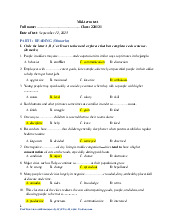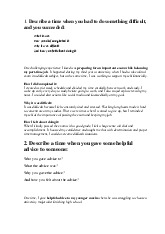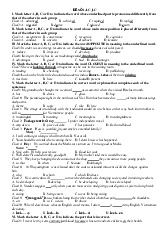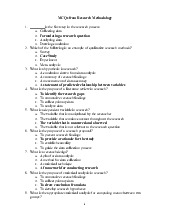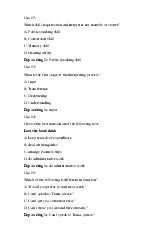












Preview text:
ÔN TẬP UNIT 4 KEY Câu 18:
A pension plan is a plan to help people save money for when they (RETIRE) from work. A. retire B. retired C. retiring D. retirement Câu 19:
It refers to the tools and techniques used to assess a candidate's knowledge, skills, and abilities. A. Recruitment Methods B. Assessment Tools C. Selection Criteria D. Hiring Practices Câu 20:
This recruitment term refers to the formal procedure of welcoming and
integrating new employees into the organization. A. Orientation B. Training C. Onboarding D. Induction Câu 21:
It is a recruitment method where a third party identifies and recommends
candidates for specific positions. A. Headhunting B. Outsourcing C. Job Posting D. Employee Referral Câu 22:
This term describes a candidate's potential to grow and perform in future roles within the organization. A. Cultural Fit B. Leadership Potential C. Growth Potential D. Skills Assessment Câu 23:
It is a recruitment practice that targets candidates from specific industries or job functions. A. Headhunting B. Targeted Recruitment C. Mass Recruitment D. Campus Recruitment Câu 24:
This type of assessment evaluates a candidate's behavior in job-related situations. A. Behavioral Interview B. Situational Judgement Test C. Skills Test D. Competency Assessment Câu 25:
It refers to the practice of maintaining a relationship with potential candidates
even if there are no current job openings. A. Networking B. Talent Pipelining C. Recruitment Marketing D. Candidate Engagement Câu 26:
This recruitment technique involves using data and metrics to make informed hiring decisions. A. Recruitment Analytics B. Talent Acquisition C. Data-Driven Recruitment D. Workforce Planning Câu 27:
It is a recruitment process that focuses on understanding and meeting the
unique needs of different groups of candidates. A. Diversity Recruitment B. Targeted Recruitment C. Inclusive Recruitment D. Customized Recruitment Câu 28:
It refers to the measures taken to ensure the health and safety of employees in the workplace. A. Job Security B. Labor Protection C. Compensation D. Work-Life Balance Câu 29:
This act regulates the minimum wage, overtime pay, and child labor standards. A. Fair Labor Standards Act
B. Occupational Safety and Health Act
C. Family and Medical Leave Act D. Civil Rights Act Câu 30:
It involves protecting workers from hazards that can cause injuries or illnesses. A. Job Analysis
B. Occupational Health and Safety C. Performance Appraisal D. Job Rotation Câu 31:
This term refers to a law that prohibits discrimination based on race, color,
religion, sex, or national origin. A. Equal Pay Act
B. Age Discrimination in Employment Act C. Civil Rights Act
D. Americans with Disabilities Act Câu 32:
It is a workplace practice aimed at preventing and addressing sexual harassment. A. Code of Conduct B. Sexual Harassment Policy C. Discrimination Policy D. Diversity Training Câu 33:
This policy ensures that employees can take unpaid, job-protected leave for family and medical reasons. A. Workers' Compensation
B. Equal Employment Opportunity
C. Family and Medical Leave Act
D. Health Insurance Portability and Accountability Act Câu 34:
It refers to the use of protective equipment to minimize exposure to workplace hazards.
A. Personal Protective Equipment (PPE)
B. Employee Assistance Program (EAP) C. Health and Safety Audit D. Ergonomics Câu 35:
This term describes a systematic process to evaluate and reduce risks associated with job tasks. A. Risk Assessment B. Job Safety Analysis C. Health Surveillance D. Accident Investigation Câu 36:
It involves programs designed to help employees with personal problems that
might affect their work performance. A. Health Insurance
B. Employee Assistance Program (EAP) C. Job Training D. Career Counseling Câu 37:
This type of insurance provides benefits to employees who suffer work-related injuries or illnesses. A. Life Insurance B. Health Insurance C. Workers' Compensation D. Unemployment Insurance Câu 38:
It is a formal written statement that specifies the responsibilities and duties of
both employers and employees regarding health and safety. A. Job Description B. Safety Policy C. Employee Handbook D. Code of Conduct Câu 39:
This term refers to the science of designing the job, equipment, and workplace to fit the worker. A. Physiology B. Ergonomics C. Occupational Therapy D. Industrial Engineering Câu 40:
It involves regular examination and monitoring of employees' health to prevent occupational diseases. A. Health Surveillance B. Risk Assessment C. Performance Appraisal D. Job Safety Analysis Câu 41:
It refers to training provided to employees about potential hazards and safe work practices. A. Induction Training B. Safety Training C. Skills Training D. Management Training Câu 42:
This term describes efforts to create a workplace that supports the physical and
mental well-being of employees. A. Job Enrichment
B. Health and Wellness Programs C. Performance Management D. Job Enlargement Câu 43:
It involves investigating workplace accidents to determine the cause and prevent future occurrences. A. Safety Training B. Risk Assessment C. Accident Investigation D. Health Surveillance Câu 44:
This type of hazard includes harmful physical agents such as noise and radiation. A. Chemical Hazard B. Biological Hazard C. Ergonomic Hazard D. Physical Hazard Câu 45:
It is the responsibility of ensuring that workplace practices comply with safety regulations and laws. A. Human Resource Management B. Compliance C. Employee Relations D. Workforce Planning Câu 46:
It is a report that employers must file when an employee is injured or becomes ill due to work conditions. A. Accident Report B. Health Surveillance Report C. Job Safety Analysis D. Risk Assessment Câu 47:
This type of protection involves safeguarding employees from harmful chemicals used in the workplace. A. Physical Protection B. Chemical Safety C. Biological Safety D. Fire Safety Câu 48:
This term refers to adjustments made to the workplace to accommodate employees with disabilities. A. Workplace Design B. Reasonable Accommodation C. Ergonomics D. Health and Safety Policy Câu 49:
It is the obligation of an employer to ensure that their workplace is free from known dangers. A. Duty of Care B. Job Security
C. Equal Employment Opportunity D. Workforce Planning Câu 50:
This term refers to the entitlements and protections that employees are granted under labor law.
A. Occupational Health and Safety B. Workers' Compensation C. Employee Rights D. Job Satisfaction Câu 51:
This law prohibits employment discrimination against individuals 40 years of age or older. A. Civil Rights Act
B. Americans with Disabilities Act
C. Age Discrimination in Employment Act D. Equal Pay Act Câu 52:
It refers to the right of workers to participate in decisions affecting their health and safety. A. Collective Bargaining B. Employee Involvement
C. Health and Safety Committee D. Worker Representation Câu 53:
It involves continuous improvement of health and safety standards within the workplace. A. Risk Management B. Health and Safety Culture C. Job Safety Analysis D. Compliance Câu 54:
It is a workplace strategy that aims to prevent workplace violence and ensure a safe environment. A. Conflict Resolution B. Safety Training
C. Workplace Violence Prevention
D. Employee Assistance Program (EAP)
Câu 55: Reward is the compensation which an employee receives from an organization mainly refer to for his or her service. A. enterprises B. companies C. organizations D. offices
Câu 56: Reward has compensatory function; it is an exchange of the service one employee has
or the retribution for the done work. A. done B. offered C. made D. given Câu 57:
Using database technologies, and online job advertising boards and search engines, employers can
now fill posts in a fraction of the time possible. A. Permanent B. Temporary C. Previously D. Currently
Câu 58: Employee relation is concerned with and resolving problems
involving individuals which arise out of affect work situations. A. preventing B. doing C. coming D. concerning Câu 59: The progressive
and regulatory and other requirements must be considered. A. styles B. leadership C. discipline D. negotiation
Câu 60: Information is provided to employees to a better
understanding of management’s goals and policies. A. promote B. place C. agree D. manage
Câu 61: The company offered an annual
to its top-performing employees. A. incentive B. decrement C. penalty D. wage
Câu 62: Employees are often motivated by
rewards such as recognition and praise. A. tangible B. intangible C. financial D. variable
Câu 63: Performance-based bonuses are typically tied to . A. seniority B. attendance C. achievement of goals D. job title
Câu 64: The HR department decided to implement a
scheme to reward employees who exceed their sales targets. A. merit-based B. flat-rate C. fixed-term D. discretionary Câu 65:
bonuses are often given during holiday seasons as a token of appreciation to employees. A. Year-end B. Monthly C. Quarterly D. Annual Câu 66:
is the term used for an extra payment made to employees for working additional
hours beyond their regular schedule. A. Overtime pay B. Base salary C. Commission D. Stipend
Câu 67: The HR manager suggested offering a
to attract talented candidates to the company. A. referral bonus B. salary cut C. demotion D. penalty Câu 68:
is a common practice to retain key employees by offering them shares or stock options in the company. A. Equity compensation B. Severance pay C. Deferred compensation D. Wage garnishment
Câu 69: The company's policy on
includes health insurance, retirement plans, and vacation days. A. benefits package B. salary negotiations C. performance reviews D. workplace culture Câu 70:
is the term used to describe the process of adjusting an employee's salary to
account for cost of living increases or inflation. A. Salary freeze B. Salary benchmarking C. Salary adjustment D. Salary compression
Câu 71: The HR department is responsible for
employee compensation and benefits packages. A. analyzing B. reducing C. outsourcing D. enhancing Câu 72:
refers to the practice of paying employees based on the number of hours worked rather than a fixed salary. A. Hourly wage B. Annual salary C. Piece rate D. Salaried Câu 73: The company's
policy ensures that all employees are compensated fairly for their
work regardless of gender, race, or ethnicity. A. diversity and inclusion B. pay equity C. performance appraisal D. talent acquisition
